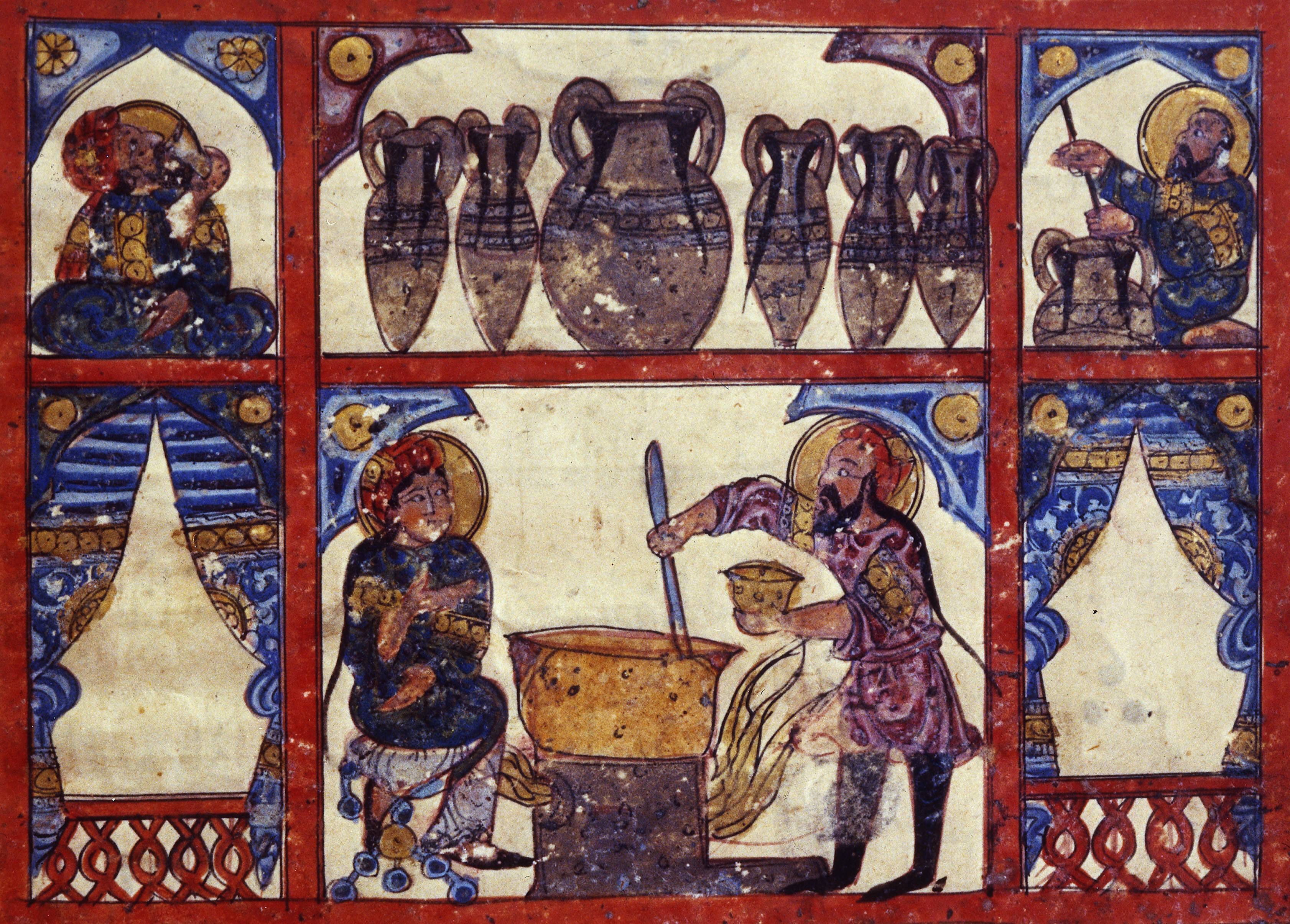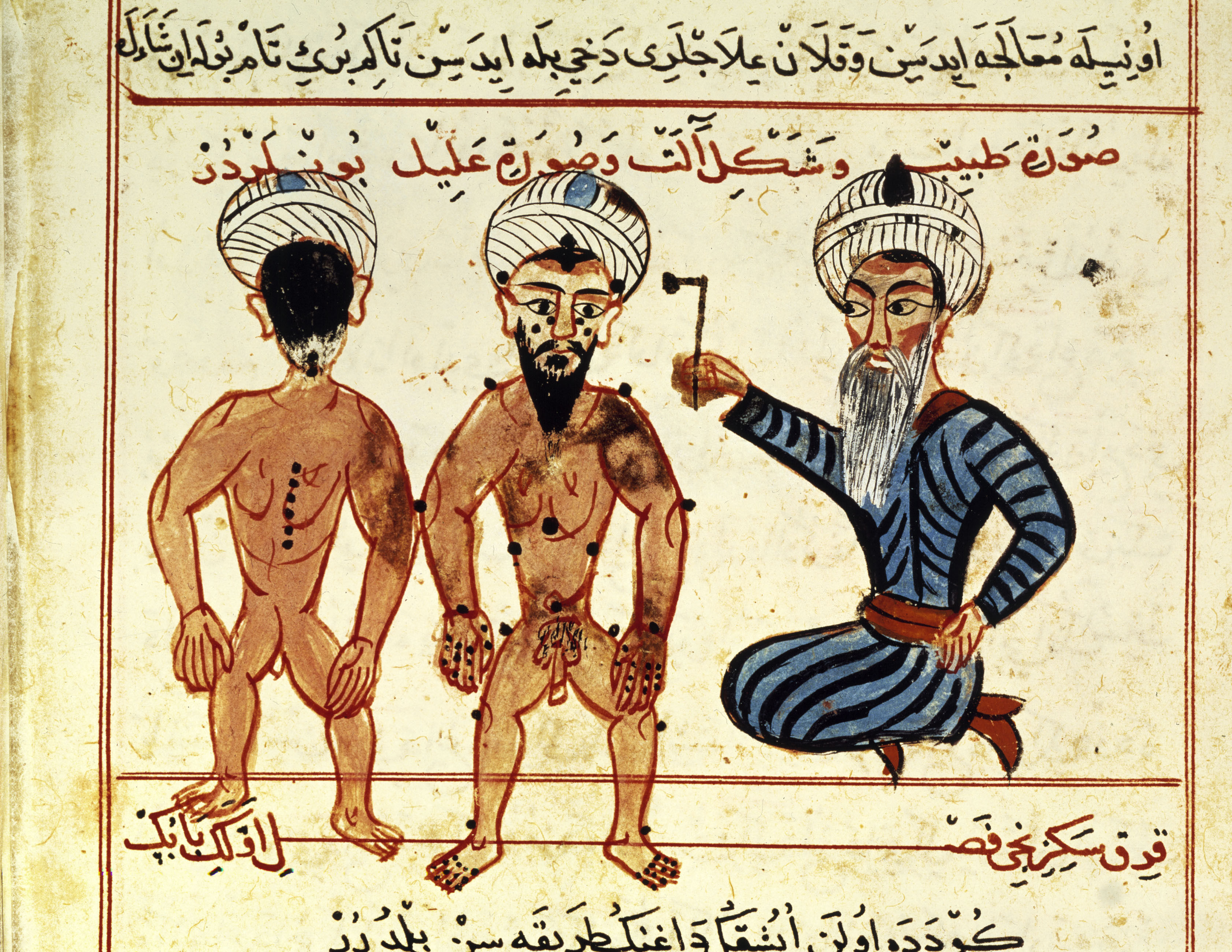The success of early Arab medicine against epidemics

Abbasid polymath Abd al-Latif al-Baghdadi saw through the three young men pretty quickly. He met them at the al-Nuri hospital in Damascus, young Persians who had feigned pain in order to spend a few days in the hospital, with its muqarnas dome and leafy courtyard. The doctor treating them, al-Baghdadi wrote in his travelogue, did not let on. Only on the fourth day did he confront the patients and say with a smile on his face: "Traditional Arab hospitality lasts three days: so please go home!"
The incident took place in the 13th century, in what is now Syria's oldest surviving hospital. Nur ad-Din Zengi of the Turkish Zengid dynasty had it built in 1154. Until the start of the Syrian war in 2011 what is now the Museum of Medicine and Science in the Arab World attracted many visitors and tourists. Why the men voluntarily spent three days in a hospital would still not have made sense just a few centuries later – and certainly not in the age of COVID-19.
Images of overcrowded treatment rooms, of patients reduced to hoping for ventilator slots, of corpses being transported away from hospitals in refrigerated trucks have been circulating ever since the current pandemic started. These days, hospitals are seen by many as places best avoided – unless you can't breathe.
An oasis of well-being rather than an infirmary
All the more reason to reflect on the hospital as an institution. A glance back in time reveals how ideas varied among the different peoples at that time. While those who fell ill in the European Middle Ages were banished to so-called infirmaries outside the city gates, where the sick were isolated from society and mostly dependent on the mercy of wealthy donors, patients were treated very differently in the Islamic world. From the descriptions of these institutions included in travel accounts by contemporary Arab and Persian geographers, physicians and scholars, the impression is frequently more of fancy rehabilitation clinics or spiritual oases of well-being, than of mediaeval infirmaries.
Ibn Jubayr, the founder of the so-called 'rihla' literature (Arabic for journey), compared the al-Muqtadiri hospital on the banks of the Tigris in the 12th century to a "royal palace where all comforts are provided". These descriptions provide insights into an era when such hospitals were flourishing in the great Muslim metropolises of Damascus, Cairo, Cordoba and Baghdad. Al-Baghdadi, who at the age of 26 travelled to Syria, Palestine, Egypt, Armenia and Turkey, solves the mystery of the three young Persians a few lines later: It was the "excellent food and service at the hospital" that had attracted the men.

Indeed, in the early Islamic bimaristan, patients found free medical treatment, clean rooms and free – and apparently tasty – food. The name 'bimaristan' comes from Persian and can be translated as "house of the sick". Under the Abbasid caliph Harun al-Rashid (763-809), of Arabian Nights fame, there are said to have been several hundred hospitals in Baghdad. Considered today to be the forerunners of modern hospitals, bimaristan had high ethical standards.
They were run secularly, with doctors treating people of any race and religious affiliation. They were forbidden by law to turn away destitute or travelling patients. Muslim, Jewish and Christian physicians all found employment within their walls.
"All costs are to be borne by the hospital"
The policy statement of Qalawun Hospital, built in Cairo in the 13th century by the Mamluk sultan Saif ad-Din Qalawun al-Alfi al-Mansur, states that the hospital shall accommodate all patients, men and women, until they are fully recovered.
"All costs are to be borne by the hospital, regardless of whether people are from far or near, residents or foreigners, strong or weak, of high or low status, rich or poor, employed or unemployed, blind or visually impaired, physically or mentally ill, educated or illiterate. There are no conditions regarding recompense and payment; no one shall be challenged or even indirectly notified of non-payment. The entire service is provided through the generosity of God, the Generous One."
Qalawun Hospital, which continued to exist for 400 years into the 19th century, formed part of the Qalawun complex, still to be found on Al-Muizz Street in the Islamic Old City of Cairo. It has been a UNESCO World Heritage Site since 1979.
The modern-day concept of private patients, who are often entitled to treatment by a consultant, would no doubt have been frowned upon at the time. For example, the Spanish professor of humanities Víctor Palleja de Bustinza writes in National Geographic History magazine that even beggars in Baghdad could have been operated on by medical greats like the Persian doctor Abu Bakr Muhammad ibn Zakariya al-Razi.
This almost Utopian-sounding approach to treatment was possible because of the key role the waqf system played in Islamic society. Paying alms tax is a religious duty for Muslims and is considered one of the five pillars of Islam. Public hospitals were thus financed primarily by endowments from wealthy Muslims.
A saying of the Prophet Muhammad also served as a special guiding principle for many medical practitioners during the early Islamic period. He said: "Allah has not sent down a disease without at the same time sending down a cure for it." But even bimaristan would have reached their limits during pandemics.
Muslim scholars such as Ibn Abi al-Dunya from the 9th century or Ibn Hajar al-Asqalani from the 15th century warned in their works against crowds during contagious epidemics and strongly advised against communal prayers. In December 1429, al-Asqalani wrote, the plague led to 40 deaths in Cairo in a single day. When people prayed for an end to the plague a month later, the death rate rose to more than 1000 per day. To what extent early Islamic physicians in the bimaristan were able to adhere to their noble principles when confronted with the plague is not known. Even the most advanced doctors of the time were unable to find a cure.

"Guardians of souls and bodies"
Centuries later, doctors around the globe have been called upon to make life-and-death decisions during the coronavirus pandemic. Using fast-track procedures, they have had to decide whose chance of survival is greater, thus confronting the limits of medical ethics. In Europe, the oath of the Greek physician Hippocrates (4th century BC) is best known in this regard. In the early Islamic period, Arab physicians expanded upon the knowledge of the ancients.
Arab physician Ishaq ibn Ali al-Ruhawi wrote the first book on medical ethics entitled "Adab al-Tabib" ("The Conduct of a Physician") in the 9th century. He described doctors as "guardians of souls and bodies". In twenty chapters, he explains why the interplay of mental and physical powers is crucial. He sums up that mental health is particularly important and that its violation can also lead to physical illness – what we refer to these days as psychosomatic illness. The Persian physician al-Razi also promoted a holistic approach to healing in his book "Kitabul-Tibb al-Rawhani" (The Book of Spiritual Medicine).
Doctors in the early Islamic world already attached great importance to the mental health of the patients. This was also reflected in the much-described atmosphere of the bimaristan: the fountain in the leafy inner courtyard, the splashing of the water and the warm rays of the sun were intended to have a calming effect on the patients. The melodious tones of the oud, an oriental lute, and the ney, a flute, resound through the halls of the bimaristan. The scent of jasmine blossoms is also mentioned in several contemporary travel accounts.
Islamic physicians thus drew on the Greek tradition of therapy through music. They too were convinced that body and mind must be in harmony for healing, especially for patients with mental illness. Sufis - Islamic mystics – always emphasised the spiritual aspect of music, believing that music would bring people closer to God, which could help patients in crisis situations.
It was also Al-Razi who had the first psychiatric ward set up in a hospital in Baghdad. At a time "when people in the Christian world believed that mentally ill people were possessed by the devil", as the British-Iraqi historian of science Jim Al-Khalili writes in his book "In the House of Wisdom", this was an enormous scientific advance.
In the bimaristan, such patients were placed in a separate ward. The hospitals were divided into distinct wards, such as those for infectious and those for non-infectious diseases, eye diseases, surgical and non-surgical cases. Men and women were housed separately and cared for by same-sex staff. In most cases, the hospitals were located in close proximity to universities, where students and their teachers read, commented on, interpreted and independently developed the great works of antiquity in Arabic. Medical students accompanied doctors on their rounds and kept medical records.
These physicians already implemented basic ideas of hygiene. Before building a new hospital in Baghdad, the Abbasid caliph al-Muktafi (875 - 908) asked the physician al-Razi to find the perfect location for it. So al-Razi had fresh pieces of meat hung up in various districts of Baghdad. A few days later, he checked the degree of decay of the pieces. Where it was lowest, the air was purest – and thus suitable for a new bimaristan.
[embed:render:embedded:node:39498]
When the Mongols completely destroyed the Abbasid caliphate in Baghdad, sacking the famous city and slaughtering its inhabitants in 1258, a historical heyday of science, not only medical science, also came to an end. Two centuries later, the Arab Muslims were driven out of Spain in the course of the so-called Reconquista. With Granada, writes Islamic scholar Fuat Sezgin in his book "Science and Technology in Islam", the Arabs not only lost the last bastion of their eight-hundred-year rule on the Iberian Peninsula in 1492, but the loss also marked the definitive end of the Arab-Islamic world power. The Crusades (1096-1291) had also weakened the Islamic world, Sezgin writes.
However, these are only some of the reasons for the onset of stagnation and the demise of creativity. Looking at the region today, the narratives about the bimaristan recede into the distance, at least in many places.
Today, healthcare in many Arab countries is ramshackle and expensive
Today, healthcare in most Arab countries – apart from the oil-rich Gulf states – is ramshackle and expensive. People from the middle and lower classes in particular, who often live together in small spaces, are helplessly at the mercy of the corona virus. Public hospitals are often in disastrous condition, and most citizens cannot afford expensive private clinics.
In the overcrowded prisons in the Middle East, too, hygiene conditions are deplorable. Human rights organisations have frequently warned of mass deaths in prisons during the ongoing pandemic. Countries like Egypt and Syria, where tens of thousands of people are imprisoned mainly for political reasons, have refused to take protective measures for their prisoners. Iran ordered prison reprieves for 100,000 inmates at the end of March 2020. Tunisia, Algeria, Morocco, Jordan and Bahrain followed suit and also opened some of their prisons.
The treatment of people on the margins of society has also been the subject of much discussion recently. How can homeless people protect themselves from the virus? How do refugees, the mentally ill or prisoners fare?
More than a thousand years earlier, the Abbasid vizier Ali ibn Isa ibn al-Jarrah (859-946) dealt with this question. Reacting to the particularly high number of diseases that plagued his reign, he wrote in a letter to the physician Sinan ibn Thabit that he was "very worried about the prisoners". Their large numbers and conditions in the prisons could cause disease to spread quickly. Therefore, he said, they should have their own doctors, who would examine them every day and give them medicine if necessary. A short time later, with the help of donations, a separate hospital was built for prisoners.
© Sueddeutsche Zeitung/Qantara.de 2021
